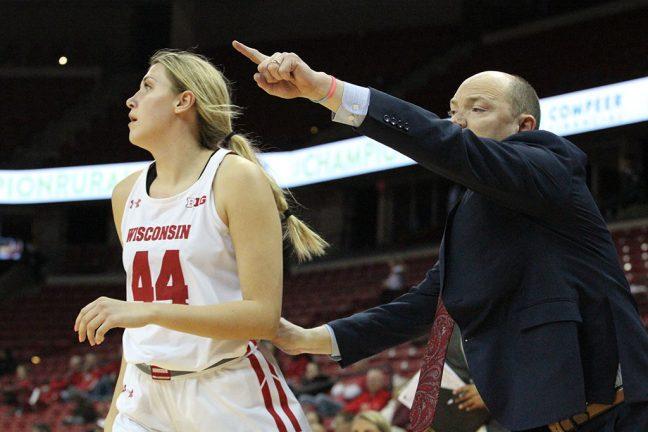Head Coach Jonathan Tsipis made a major adjustment to the starting lineup for the University of Wisconsin women’s basketball team’s (4-13, 1-12 Big Ten) game against Penn State (8-7, 5-6). Replacing usual starting center Sara Stapleton was sophomore forward Tara Stauffacher, meaning the Badgers were going small. The change did little to impact winning, however, as the Badgers fell, 98–74.
While Wisconsin was able to shoot a modest 47% from the field, the primary offensive woe for this Badger team persisted. Wisconsin’s backcourt committed 16 of the team’s 22 turnovers, with Julie Pospíšilovà responsible for eight of them. Wisconsin has turned the ball over 20 or more times five times this season, leading the Big Ten.
On the other end, the Badgers’ defense did little to stop Penn State’s offensive flow. The Nittany Lions only turned the ball over three times. Some more jaw-dropping numbers in favor of Penn State were a 37–4 points-off-turnovers advantage and a 33–8 advantage in transition points.
The lack of effort on the defensive end led to an unstoppable team effort from Penn State. Four double-digit scorers — including a 20-point game from sophomore guard Makenna Marisa — and 26 assists would be good enough to compete with the top tier of the Big Ten, making it more than enough to put away Wisconsin in the second half.
The good news is that Wisconsin’s half-court offense was able to find good looks when the end result wasn’t a turnover. Stapleton looked calm and collected coming off of the bench while Sydney Hilliard and Imani Lewis contributed their typical numbers. Lewis collected her sixth straight double-double with 18 points and 10 boards.
The most evident problem from Tsipis’ squad is one that has put a cap on the team’s success all season long — not maximizing Pospíšilovà potential as a playmaker. Though her ball-handling skills must develop in order to become the perfect running mate alongside Hilliard, she is the team’s best creator in a half-court setting.
Though she led the way with six assists, her aforementioned turnover count extinguishes Wisconsin’s chances to compete in the Big Ten. Instead of being the primary ball-handler, running some backdoor action to get Pospíšilovà in the mid-post “playmaker spot” could exponentially increase her potency as a passer.
The blame doesn’t stop here, the team’s best shooter, graduate transfer Estella Moschkau, only shot twice in 18 minutes. Though others on the team can make threes with consistency, Moschkau is a bona fide threat. More importantly than collapsing on the paint, Moschkau’s exclusion from the offense allows teams to prioritize help defense and play passing lanes.
The two combined for three points on 1-of-8 shooting from 3-point land. Both have sharp tools that have been routinely underused. The Badgers are much easier to guard when Tsipis and his staff fail to use their weapons.
Wisconsin is running out of chances to salvage the season. The Badgers have to capitalize on the highly specific set of skills that their best playmakers possess. The next chance to get a win is Wednesday, Feb. 10 against No. 11 Ohio State at the Kohl Center.


